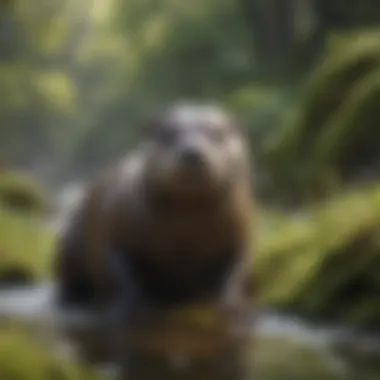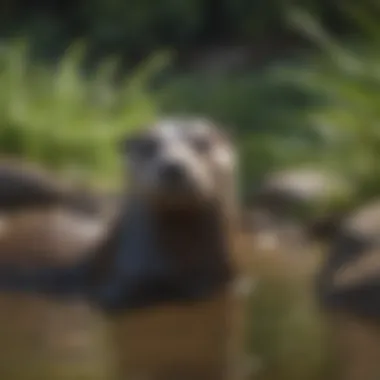Dive into the Enigmatic World of North American River Otters


Animal Spieces Profile
North American River Otters are fascinating creatures that inhabit various water bodies across the continent. Their sleek, elongated bodies are designed for agility in the water, sporting thick fur for insulation against cold temperatures. These otters prefer freshwater habitats, such as rivers, lakes, and wetlands, where they can hunt for fish, crustaceans, and other aquatic prey. Known for their playful nature, river otters are often found in social groups engaging in cooperative hunting and playful antics. Bottom trawling for food in the murky depths, their dexterous paws and sharp teeth aid in capturing elusive prey.
Conservation & Wildlife Effots
Despite their resilient nature, North American River Otters face a variety of threats to their survival. Habitat loss due to urban development and pollution poses significant risks to their populations. Several conservation organizations are actively working to protect these otters, implementing measures to restore their habitats and mitigate human-induced threats. Success stories of rehabilitation and release programs highlight the positive outcomes of dedicated conservation efforts, showcasing how collaborative initiatives can benefit otter populations.
Animal Behavior & Psychology
Communication plays a vital role in the social structure of North American River Otters. Using a combination of vocalizations, body language, and scent markers, these otters establish territories, convey warnings, and communicate mating readiness. Their reproductive behavior is also interesting to observe, with elaborate courtship rituals and cooperative parenting strategies. Studies have shown that river otters exhibit problem-solving skills, using tools like rocks to crack open shellfish for food, demonstrating their cognitive abilities and adaptability in diverse environments.
Unique Facts & Trivia
Beyond their physical adaptations, North American River Otters boast intriguing quirks and behaviors. For instance, these otters are known to slide down muddy embankments and snow-covered slopes for fun, showcasing their playful nature. Little-known facts include their ability to stay submerged underwater for several minutes while hunting, aided by physiological adaptations that allow them to conserve oxygen. Their buoyant bodies and webbed feet contribute to their excellent swimming abilities, allowing them to navigate swiftly through the water in pursuit of prey.
Introduction to North American River Otters
Exploring the realm of North American River Otters unveils a tapestry of intriguing information about these semi-aquatic mammals. Delving into the habitat, behavior, diet, and conservation status of these creatures opens a window to appreciate their critical role in the ecosystem. By dissecting the nuances of their existence, we gain valuable insights into the interconnectedness of all living beings.
North American River Otter Overview
North American River Otters present a fascinating study in adaptability and survival. From their Physical Characteristics to their Habitat and Range, each aspect offers a unique perspective on their evolutionary journey. Their Social Structure provides a glimpse into their societal dynamics, revealing how these creatures navigate their world with intricate behaviors and communication patterns.
Physical Characteristics
The physicality of North American River Otters serves as a testament to their aquatic prowess. Their sleek, streamlined bodies, complemented by webbed feet, enhance their swimming abilities and make them efficient predators in water. The insulating fur not only keeps them warm but also aids in buoyancy, allowing for seamless navigation through various water bodies. This amalgamation of features equips them for a life predominantly spent in aquatic environments.
Habitat and Range
The habitat preferences and vast range of North American River Otters underscore their adaptability to diverse ecosystems. From freshwater rivers to coastal estuaries, these otters carve out their territories with precision, showcasing a flexible approach to survival. Their ability to thrive in both marine and freshwater environments reflects a resilience that is essential for their long-term sustainability.
Social Structure
Within their communities, North American River Otters exemplify intricate social bonds and roles. Their cooperative hunting techniques and vocalizations highlight a sophisticated level of communication. This social cohesion not only aids in hunting success but also fosters strong familial ties, essential for the survival of the group.
Historical Significance


The historical relevance of North American River Otters transcends time, encompassing their significance in Indigenous Cultures and Folklore. These creatures have woven themselves into the tapestry of human narratives, symbolizing various aspects of culture and tradition.
Role in Indigenous Cultures
In Indigenous Cultures, River Otters often symbolize qualities like adaptability, creativity, and resilience. Stories and legends surrounding these otters vary across tribes, with each tale carrying profound meanings reflective of the otter's characteristics. Their presence in indigenous folklore speaks to the intrinsic connection between humans and the natural world.
Otters in Folklore
Similarly, in folklore, North American River Otters often embody traits such as playfulness, curiosity, and adaptability. These creatures serve as protagonists in myths and fables, imparting moral lessons and cultural values through their actions. Through folklore, otters take on mythical qualities, becoming symbols of whimsy and wisdom.
Behavioral Traits of North American River Otters
Behavioral traits play a crucial role in understanding the North American river otters fully. By delving into the foraging and hunting behavior as well as their reproduction and parenting habits, we can gain valuable insights into the lives of these fascinating mammals. Behavioral traits reveal not just their daily routines but also shed light on their survival strategies and social dynamics.
Foraging and Hunting Behavior
Diet Composition
Looking at the diet composition of North American river otters is pivotal to comprehending their behavior and ecological niche. Their diet primarily consists of fish, crustaceans, and amphibians, emphasizing their carnivorous nature and role as skilled predators in aquatic ecosystems. The high protein content in their diet sustains their energy-intensive lifestyle, aiding in maintaining their playful and agile demeanor, which is vital for their survival.
Hunting Techniques
The hunting techniques employed by North American river otters are a testament to their adaptability and intelligence. They use a combination of stealth, agility, and keen sensory perception to capture prey efficiently. Their use of cooperative hunting behaviors showcases their social nature and ability to work together for successful hunts. However, their reliance on a specific set of hunting techniques also exposes them to potential risks and challenges, given the dynamic nature of their aquatic environment.
Reproduction and Parenting
Exploring the mating habits and parenting behaviors of North American river otters provides a glimpse into their reproductive strategies and family dynamics. Understanding how otters choose mates and care for their young highlights the species' commitment to ensuring the continuity of their lineage. From playful courtship rituals to the intricate nurturing of offspring, these behaviors exemplify the depth of their emotional connections and the importance of family bonds in otter communities.
Mating Habits
The mating habits of North American river otters involve complex rituals that strengthen pair bonds and facilitate successful reproduction. Their monogamous tendencies and seasonal breeding patterns optimize genetic diversity within populations, promoting the overall health of the species. However, mating behaviors also involve competition and potential conflicts, reflecting the intricate balance between individual desires and collective needs in otter societies.
Caring for Offspring
The dedication shown by North American river otters in caring for their offspring underscores the significance of parental investment in the species' survival. From building secure dens to teaching essential survival skills, otter parents engage actively in the upbringing of their young. This hands-on approach not only fosters the development of strong familial relationships but also equips the next generation with the necessary tools to thrive in their aquatic habitats.
Adaptations for Aquatic Life
In the in- depth exploration of North American River Otter facts, the section on adaptations for aquatic life plays a pivotal role in unraveling the intricacies of how these fascinating mammals have evolved to thrive in water-based environments. Understanding the specific adaptations that North American River Otters possess sheds light on their remarkable ability to navigate and survive in their aquatic habitats. The adaptations discussed in this section shed light on the specialized attributes that have been honed through generations to ensure the otters' successful existence in water.


Physical Adaptations
Webbed Feet:
Delving into the realm of North American River Otters' physical adaptations, the feature of webbed feet stands out as a remarkable asset that aids in their aquatic pursuits. The tubercles and webbing between their toes allow for enhanced propulsion and agile movements while swimming. This unique characteristic of webbed feet enables otters to paddle with efficiency, making them adept swimmers in rivers and lakes. The significance of webbed feet aligns perfectly with the otters' aquatic lifestyle, showcasing nature's precision in equipping them for aquatic survival.
Insulating Fur:
Another crucial element of the physical adaptations of North American River Otters is their insulating fur. This dense fur layer provides buoyancy and insulation against the cold waters, enabling otters to regulate their body temperature efficiently. The waterproof nature of their fur prevents heat loss in water, crucial for maintaining their energy levels during swimming and diving activities. The insulating fur serves as a protective barrier, ensuring otters can thrive in varying water conditions, showcasing the adaptive prowess of these aquatic mammals.
Behavioral Adaptations
Playful Nature:
Examining the behavioral repertoire of North American River Otters, their playful nature emerges as a defining characteristic that enhances their adaptability in the wild. Through playful activities such as sliding down muddy banks or engaging in water-based games, otters hone their agility and coordination skills essential for hunting and survival. This playful behavior not only contributes to their physical development but also fosters social bonds within otter communities, highlighting the multifaceted advantages of their jovial demeanor.
Diving Abilities:
The diving abilities of North American River Otters represent a vital behavioral adaptation that sets them apart as proficient aquatic hunters. With the capability to remain submerged for extended periods, otters exhibit exceptional diving skills tailored for capturing prey underwater. Their streamlined bodies, coupled with efficient lung capacity, facilitate underwater forays in search of fish and other aquatic delicacies. The remarkable diving abilities of otters showcase their mastery of aquatic environments, underscoring their adaptability and resourcefulness in securing sustenance.
Conservation Status and Threats
In the realm of North American River Otter Facts, understanding the Conservation Status and Threats is paramount. These charismatic aquatic mammals face various challenges in their natural habitat that put their existence at risk. By delving into this topic, we gain a deeper insight into the fragile balance of ecosystems and the impacts of human activities. Conservation initiatives aim to safeguard these otters and preserve biodiversity, highlighting the interconnectedness of all life forms.
Human Impact on River Otter Population
Habitat Loss
Within the context of river otters, Habitat Loss stands out as a critical issue contributing to their declining populations. The destruction of their natural habitats due to human encroachment and urbanization poses a severe threat to these creatures. In this article, Habitat Loss is explored in detail, shedding light on the detrimental effects on otters' survival. The unique vulnerability of river otters to habitat degradation amplifies the urgent need for protective measures and conservation efforts, making it a focal point in understanding the challenges these animals face.
Pollution
Pollution serves as another significant factor influencing the Conservation Status and Threats facing North American river otters. The contamination of their aquatic environments due to human activities introduces toxins that harm otters and disrupt their ecosystems. This subsection delves into the detrimental impacts of pollution on otters' health and habitats, emphasizing the urgent need for sustainable practices and environmental stewardship. By examining Pollution within the broader context of otter conservation, we underscore the importance of collective responsibility in preserving these invaluable species.
Conservation Efforts
In response to the pressing threats confronting North American river otters, various Conservation Efforts have been implemented to protect and restore their populations. These initiatives encompass a range of strategies aimed at mitigating habitat destruction and pollution effects, emphasizing the pivotal role of human intervention in species conservation.


Reintroduction Programs
Among the prominent Conservation Efforts are Reintroduction Programs, which focus on reintroducing otters to their native habitats to bolster dwindling populations. This section delves into the intricacies of such programs, highlighting their successes and challenges in ensuring the survival and recovery of river otter communities. By showcasing the importance of reintroduction initiatives, we underscore the significance of human intervention in revitalizing otter populations and conserving biodiversity.
Protection Measures
Complementary to Reintroduction Programs are Protection Measures aimed at safeguarding otter habitats and populations from further decline. This segment explores the diverse approaches to conservation, including habitat preservation, legislative protections, and community engagement. By elucidating the key role of Protection Measures in otter conservation, we emphasize the need for collaborative efforts in preserving these beloved creatures and their ecosystems.
Interactions with Other Species
Interactions with other species play a crucial role in the ecosystem of North American river otters. These interactions encompass a wide array of relationships that influence the behaviour, diet, and survival of the otters. Notably, understanding the dynamics between otters and other species sheds light on the intricate balance within their habitat. By exploring these interactions, we can grasp the interconnectedness of various wildlife in the ecosystem.
Predators and Prey Relations
Otters as Predators
Otters hold a significant position as predators in the ecosystem. Their adept hunting skills and strategic approach to catching prey showcase their importance in balancing the local fauna. A unique aspect of otters as predators is their ability to swiftly navigate through water, making them efficient hunters. This characteristic contributes to the overall sustainability of the otter population and aids in maintaining ecological equilibrium. Despite their prowess as hunters, otters also face challenges in competing for food resources, highlighting the delicate nature of predator-prey relationships within their environment.
Role in Food Chain
In the intricate web of the food chain, otters play a critical role. As both predators and prey, otters occupy a crucial position that impacts various levels of the ecosystem. Their consumption of specific species regulates population sizes, preventing unchecked growth that could disrupt the fragile balance of the food chain. Otters act as key players in maintaining biodiversity by influencing the distribution of species within their ecosystem. This aspect exemplifies the interconnectedness of different organisms and emphasizes the significant role otters play in ensuring ecosystem stability.
Symbiotic Relationships
Interactions with Fish
The interactions between otters and fish underscore a symbiotic relationship that benefits both parties. Otters rely on fish as a primary food source, shaping their foraging behaviour and population dynamics. At the same time, otters contribute to the regulation of fish populations, preventing overpopulation that could strain aquatic resources. This interaction highlights the intricate balance between otters and fish, demonstrating mutual dependence for sustenance and population control.
Beneficial Effects on Ecosystem
The beneficial effects of otters on the ecosystem are far-reaching. By predating on certain species, otters help in controlling populations that could otherwise overrun their environment. This predatory behaviour contributes to a healthier ecosystem by preventing monocultures and promoting species diversity. Additionally, otters' activities enhance nutrient cycling and energy flow within the ecosystem, enriching the overall biodiversity. The presence of otters in their habitat fosters a more robust and resilient ecosystem, highlighting their invaluable contribution to environmental sustainability.
Conclusion
The conclusion of this article marks a pivotal moment where the diverse aspects of North American river otters converge. As we reflect on the intricate details of their habitat, behavior, diet, and conservation status, a profound admiration for these enigmatic creatures blossoms within us. Understanding the role these otters play in the ecosystem not only enriches our knowledge but also emphasizes the delicate balance of nature. By delving into the lives of North American river otters, we gain insights that extend beyond the realms of scientific curiosity; we begin to appreciate the interconnectedness of all living beings.
Final Thoughts on North American River Otters
Appreciation for Otter Diversity
Exploring the intricacies of otter diversity reveals a tapestry of unique characteristics that contribute to the richness of their species. Their adaptive behaviors and varied physical features showcase the resilience of these remarkable mammals in adapting to diverse environments. The distinct markings and differences in size among otters highlight their ability to thrive in a range of habitats, from flowing rivers to tranquil lakes. Appreciating otter diversity not only broadens our understanding of their species but also underscores the wonder of nature's endless variations.
Call to Action for Conservation
The call to action for conservation amplifies the urgency of preserving the habitats that sustain North American river otters. Recognizing the challenges they face due to human impact galvanizes efforts towards ensuring a secure future for these charismatic animals. Implementing conservation strategies, such as habitat restoration and pollution control, becomes imperative in safeguarding otter populations. Embracing a proactive approach to conservation instills a sense of responsibility in each of us, reminding us of our duty to protect and preserve the delicate ecosystems on which otters and countless other species depend.







